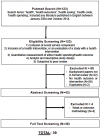Leveraging the Social Determinants of Health: What Works?
- PMID: 27532336
- PMCID: PMC4988629
- DOI: 10.1371/journal.pone.0160217
Leveraging the Social Determinants of Health: What Works?
Abstract
We summarized the recently published, peer-reviewed literature that examined the impact of investments in social services or investments in integrated models of health care and social services on health outcomes and health care spending. Of 39 articles that met criteria for inclusion in the review, 32 (82%) reported some significant positive effects on either health outcomes (N = 20), health care costs (N = 5), or both (N = 7). Of the remaining 7 (18%) studies, 3 had non-significant results, 2 had mixed results, and 2 had negative results in which the interventions were associated with poorer health outcomes. Our analysis of the literature indicates that several interventions in the areas of housing, income support, nutrition support, and care coordination and community outreach have had positive impact in terms of health improvements or health care spending reductions. These interventions may be of interest to health care policymakers and practitioners seeking to leverage social services to improve health or reduce costs. Further testing of models that achieve better outcomes at less cost is needed.
Conflict of interest statement
References
-
- McGinnis JM, Williams-Russo P, Knickman JR. The case for more active policy attention to health promotion. Health affairs. 2002;21(2):78–93. . - PubMed
-
- Lee P, Paxman D. Reinventing Public Health. Annual Review of Public Health. 1997;18(1):1–35. - PubMed
-
- Bradley E, Taylor L. The American health care paradox: Why spending more is getting us less: PublicAffairs; 2013.
Publication types
MeSH terms
LinkOut - more resources
Full Text Sources
Other Literature Sources
Miscellaneous


